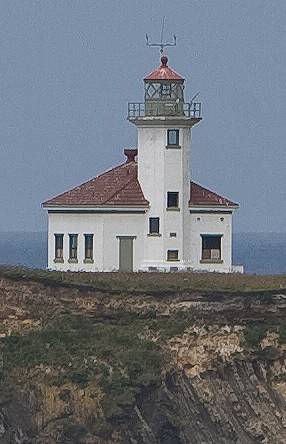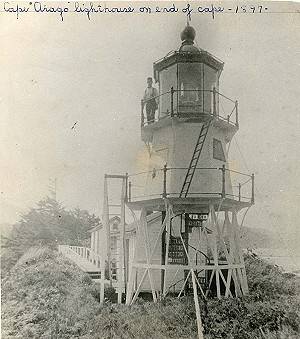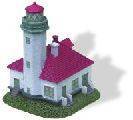|
|
Built: 1866
Type: Octagonal Attached to Fog Signal BD
Height: 44 feet
Status: Non-Active
Location: Gregory Point / Southwest of Coos Bay Entrance
Deactivated: January 1, 2006
Lens: 1866 Fourth Order Fresnel - 1998 Modern lens installed - Solar Powered
Signal: Diaphram Horn
Keepers: US Coast Guard
Notes: Oregon's first lighthouse
was built in 1855-1856 near the mouth of the Umpqua River, twenty-five
miles north of Coos Bay. However, in 1861 the overflowing river undermined
the brick tower, causing it to topple. By this time, the Coos Bay area
had surpassed the Umpqua River region in commercial importance, and it
was decided that the interests of commerce would be better served by a
new light at Cape Arago, rather than reconstructing the light at Umpqua
River. Funds were allocated accordingly, and Novermber 1, 1866, the first
Cape Arago Lighthouse was illuminated.
The octagonal, wrought iron
tower was capped with a lantern room housing a fourth-order Fresnel lens
and was supported by spindly metal legs. Located at the northern end of
the island, the tower was linked via a wooden walkway to a one-and-a-half-story
wooden keeper's dwelling, constructed near the southern end of the island.
Rowboats were initially
used to access the island, until a low bridge to the island was constructed
in 1876. However, high seas cut short the bridge's life after just two
years, and the boats were a necessity once again.
In 1878, a lifesaving station
was established on the island. Three years later, the keeper of the station,
Thomas Brown, was returning to the island from Empire City on Coos Bay,
when he was caught in a storm and blown northward. The lifesaving keeper
was now ironically in need of his own station's service. After a three-day
battle, Brown was finally able to land his craft roughly ninety miles north
of his intended destination. The lifesaving station was moved to the mainland
in 1891, where it would be more accessible.
After the low bridge to
the island was repeatedly washed away, bids were solicited in 1889 for
the construction of a more robust high bridge, to link the island to the
mainland. All of the submitted bids were deemed exorbitant, and a cable
tramway was built instead in 1891. Two frame towers, one on the island
and one on the mainland, supported a 400-foot long cable, and the ends
of the cable were anchored in concrete. This new means of accessing the
island also proved to be perilous. Just over a month before a high bridge
was finally completed in July of 1898, keeper Thomas Wyman, his daughter,
and two other individuals were being winched across the inlet in the cage
suspended below the tramway's cable, when disaster struck. The cable snapped,
plunging the passengers onto the rocky surf some sixty feet below. Wyman's
legs were severely injured, and one of them was subsequently amputated.
In 1896, the Cape Arago
Station received several improvements. The existing light tower was encased
in bricks and covered with stucco. A brick fog building housing a Daboll
trumpet was constructed adjacent to the tower, and a new duplex was built
for the keepers.
When the fog signal had
been in operation for just over ten years, erosion on the point endangered
the lighthouse and fog building. A wood-frame fog signal building with
an attached octagonal tower was built near the keeper's duplex. The light
and fog signal began operation on July 1, 1909. The new tower was similar
in appearance to the lighthouse that had been recently constructed at Mukilteo,
Washington.
In 1934, the wooden lighthouse
was moved a short distance to serve as the keeper's office, and Cape Arago's
third lighthouse was constructed where the second lighthouse had stood.
Perhaps seeking a more durable structure, the new lighthouse was constructed
of concrete, using the plans from Washington's Point Robinson Lighthouse.
The only surviving structures
on the island today are the third lighthouse and the high bridge constructed
in 1889 to provide access to the island. The original lighthouse was blown
up with dynamite, some time after the third lighthouse was completed.
In 2007, Senator Gordon
Smith submitted a provision as part of the Coast Guard Authorization Act
for Fiscal Year 2008 that would transfer the Cape Arago Lighthouse to the
Confederated tribes of the Coos, Lower Umpqua and Siuslaw Indians.
| Cape
Arago - OR
Scaasis Sculpture
|
Note
Cards: In the Sun
|
Oregon
Throws
|
| You Can Now | Copyright | Credits |
| Contact Us | usalights Store | Shopping Center |





